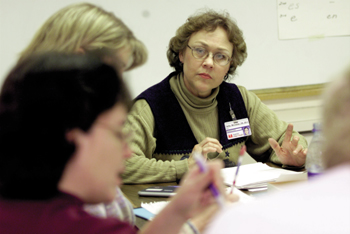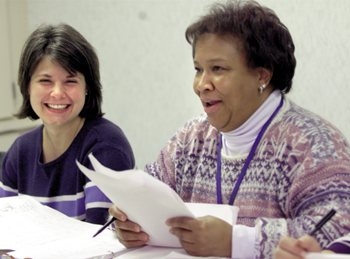
Twilla McClellan, R.N., listens to her students during Spanish class. McClellan is teaching a Spanish class to nurses who work in the NICU so they can better communicate with patients’ families. (photo by Dana Johnson)
Speaking the language –
Pediatric nurses break barriers

From left, Mary Helen Collins and Diane Boyd, both R. N.s, laugh as they try to pronounce their Spanish vocabulary in a Spanish course. (photo by Dana Johnson)
El comunicarse con los niños y los bebés enfermos es un desafío esa cara pediátrica de las enfermeras diaria. Agregue a esa dificultad una barrera linguística, y llega a ser casi imposible.
Translation from Spanish to English: Communicating with sick children and babies is a challenge that pediatric nurses face daily. Add to that difficulty a language barrier, and it becomes almost impossible.
However, thanks to the efforts of Twilla McClellan, a Vanderbilt neonatal intensive care unit R.N., speaking to Spanish families is becoming easier for other Vanderbilt staff members.
McClellan has combined her love of teaching and her love of nursing to reach out and teach fellow nurses how to communicate with Hispanic patients and their families through an intense 10-week class, which combines 20 hours of classroom training with homework and on-the-job training.
It was a thirst for knowledge that led McClellan to take Spanish in junior high, high school, and college. She has also learned sign language.
“I’ve always been interested in learning,” she explained. “This all started because I put together a program that would meet a need in the nursery and it has blossomed from there.”
“Ten years ago we hardly ever had a Spanish-speaking patient or family,” McClellan said. “Now we have at least one if not more on a daily basis.”
Vanderbilt does not have a staff interpreter, but does provide for other ways to help communicate. But in the end, it’s up to the regular staff to convey messages to patients and their families. Nurses are often forced to pantomime their messages, or pull staff from other areas to help interpret what the families are telling them.”
“It’s very hard to communicate,” explained Kathy Snider, a R.N. who is taking the class. “You have a sick baby. You can’t find out what’s wrong and you can’t communicate with the parents. We recently had five Hispanic families here at one time. I think this class is great.”
“We do a tremendous amount of teaching and communication with families that have newborns in the intensive care unit,” McClellan explained. “Because of the communication barrier, simple things become a huge problem. Parents have a lot of fear anyway because of the situation their baby is in, and by us being able to communicate in their native language adds a level of comfort and trust.”
Learning a new language is not easy. It takes a tremendous amount of time of studying and memorization, as well as practice. Unless the students use the words and phrases they are learning, they will soon forget the lessons.
“That is going to be the biggest challenge,” McClellan said. “It is very scary to walk in and begin speaking to the families in Spanish. The students are afraid they will misspeak. But they have to do it, because they can’t learn without using it.”
This is the third class that McClellan has taught, graduating 16 students with another eight soon to complete their coursework. There is a waiting list of over 100 people throughout the Medical Center interested in taking the course.
“The need is tremendous,” she said. “We just are seeing so many Spanish patients.”
McClellan put the course materials together and is concentrating on teaching her students how to listen, and how to say basic phrases. Some of the phrases include: “Hello, how are you?” and “I am your baby nurse.” A more advanced class will be taught in the future, allowing the basic users to break the language barrier even further.
“I’ve had a lot of nurses from other hospitals in the area tell me this is a unique program and want to know how they can get into the classes,” said Ellen Gregory, a NICU R.N. “I’m happy that we’ve been able to do this for the betterment of our patients.”













